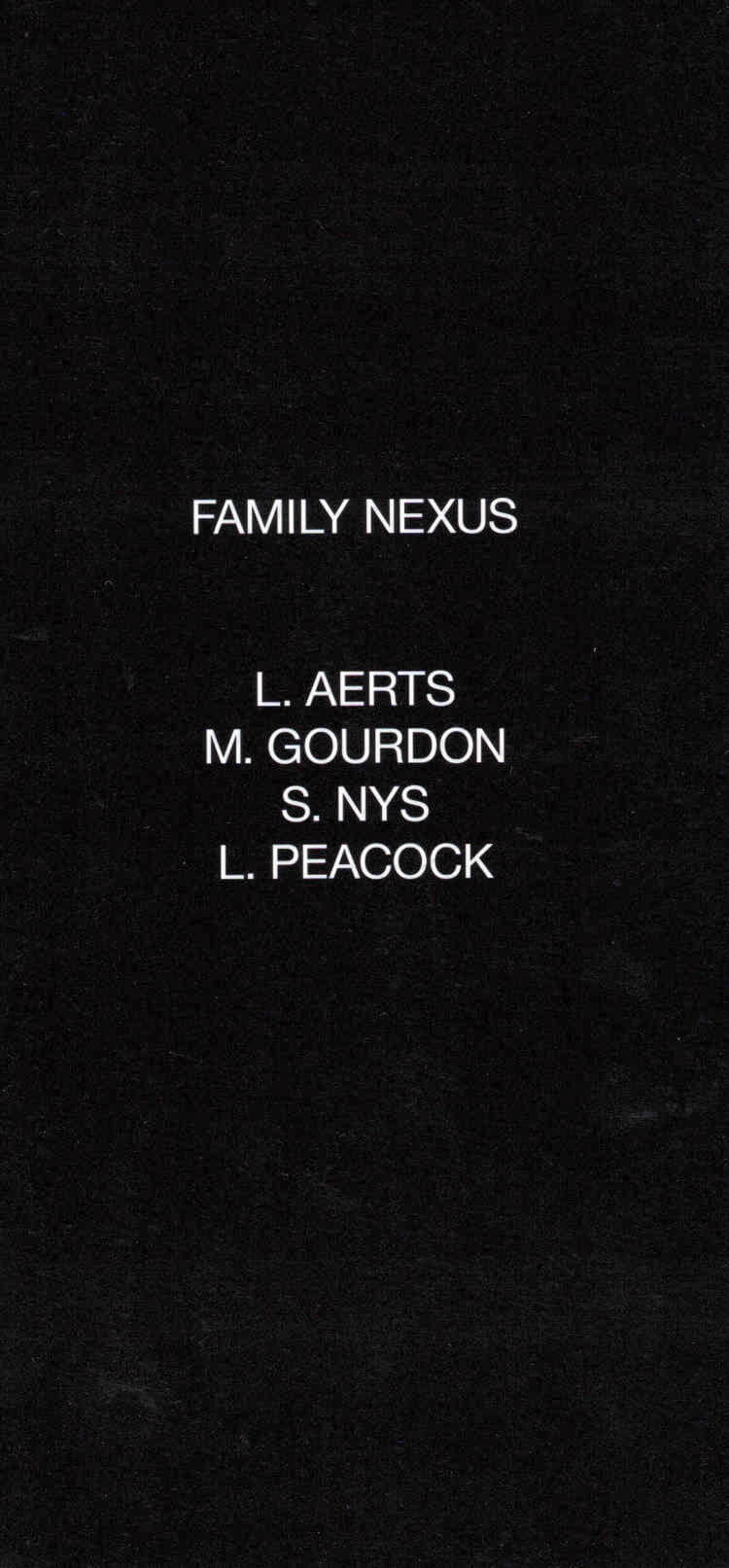
A Flower is Speaking to a dog
A set of generative texts following the genetic sequencing of DNA as the underlying structure or score for its characters.
Graphic design by Gerard Herman
Language: English

A set of generative texts following the genetic sequencing of DNA as the underlying structure or score for its characters.
Graphic design by Gerard Herman
Language: English

Sophie Nys, Liene Aerts and 2 more
In April 2019, Sophie Nys presented the solo exhibition Family Nexus at KIOSK. In psychology, a family nexus stands for a vision that is shared by the majority of family members, often unconsciously and for several generations long, and is upheld in the context of events both within the family and in its relationship to the world. Among other, the monumental, stretched out net in the dome space was a symbol of this family dynamic.
Two years later, the theme is still working its way through the above mentioned heads. The shared interest of Nys, Gourdon, Aerts and Peacock leads to a collaboration in the form of a book that, just like the exhibition, can be read as a net of (un)coherent intrigues and knots in which no position can be neutral. They set up a network of characters. Together they represent all kinds of (human) connections. Family Nexus is a story about everyone and no one in particular. Who in this book is playing the role of the Nobody, the household’s so-called 'identified patient', or scapegoat, and which pots and pans has slipped through this character’s fingers?
Co-production: KIOSK and BOEKS.
![Cover of [...]: Poems](https://rile.space/storage/3222/01JRFE9N8ZCVXTMHJAS60D283M.jpg)
From one of our most acclaimed contemporary writers, an urgent and essential collection of poems illuminating the visionary presence of Palestinians.
Fady Joudah’s powerful sixth collection of poems opens with, “I am unfinished business,” articulating the ongoing pathos of the Palestinian people. A rendering of Joudah’s survivance, [...] speaks to Palestine’s daily and historic erasure and insists on presence inside and outside the ancestral land.
Responding to the unspeakable in real time, Joudah offers multiple ways of seeing the world through a Palestinian lens—a world filled with ordinary desires, no matter how grand or tragic the details may be—and asks their reader to be changed by them. The sequences are meditations on a the past returns as the future is foretold. But “Repetition won’t guarantee wisdom,” Joudah writes, demanding that we resuscitate language “before [our] wisdom is an echo.” These poems of urgency and care sing powerfully through a combination of intimate clarity and great dilations of scale, sending the reader on heartrending spins through echelons of time. […] is a wonder. Joudah reminds us “Wonder belongs to all.”

Dance of Utter Darkness is a book of subterranean violence and brutalist design. Marked by harsh cuts and dark alcoves.
In the private void of the sewers, two cops scry new crime and punishment from the entrials of sacrified critters. Threading language from the exposed flesh into new systems of control.
You do what you can and at the end Fanon's ghost will be waiting for you.

Afternoon Editions no. 1: an essay by Jeroen Peeters titled Reseeding the library, gleaning readership. In May 2017, Time has fallen asleep in the afternoon sunshine settled during three weeks in the Ravenstein Gallery in Brussels as part of the Kunstenfestivaldesarts. Invited as a writer in residence, Jeroen Peeters visited the library of living books on a daily basis and recorded his observations by hand in a notebook, which formed the basis for Afternoon Edition #1. Reseeding the library, gleaning readership is an essay on the seed library, on the dispersion of literature through wind, water and animals, on biodiversity and commoning at the heart of readership. On the cover a drawing by Wouter Krokaert of a Philodendron Xanadu. Published May 2018.

Slant is a mail art project and a publishing house. It invites artists, designers, writers and poets to express themselves through a common theme every two weeks. it has poetry as its beacon of reflection, keeping in mind that sometimes we must tell the truth slant in order to see our reality depicted.
First edition, approx. 240pp. 4-colors riso printed.
20 x 25,5cm, 200 copies. Coptic hand-made binding.
Softcover printed wraps. French and English texts.

You wake up in the footwell of a mid-sized hatchback somewhere on a highway in outer Bangkok. You compile neurotic spreadsheets of the best ‘party destinations’ in Europe, whilst your work emails pile up without ever being read. You quit your job. You launch a banal start-up. You grieve for a past relationship. You stare endlessly at the waves coming in from a beach in Koh Pha Ngan. You vape intensely. You spend money on feelings, on the performance of your own persona, whilst you observe yourself with a detached sense of horror.
i will pay to make it bigger is a novella, by poet and artist Ahren Warner, in which ‘you’ are the main character. Through text and image – autofiction, docufiction, and just plain fiction – you work your way through a tangle of preoccupations: from what it means to buy enjoyment, to the fragile construction of your own self as a cultural product.
i will pay to make it bigger is also a photobook, a collection of images produced whilst living in Thai ‘party hostels’. Although these photographs might seem to exist as the documentation of intimate or ecstatic moments, they are in fact quite painstakingly, and artificially, constructed: composited and manipulated from multiple still frames of film footage to produce images that advertise the calculated artifice of their own hedonism, emotion and seemingly raw experience.
With a Coda by Hana K. Ohnewehr, commissioned by Yu’an Huang